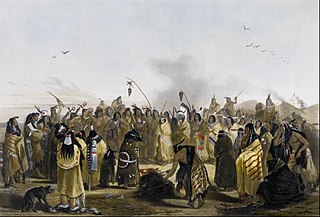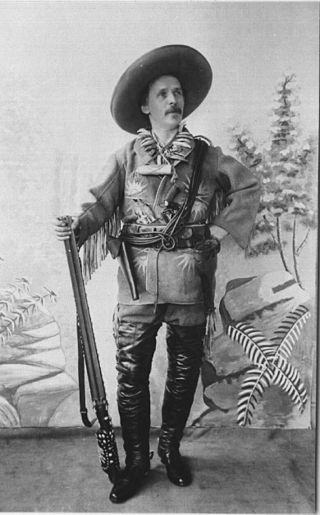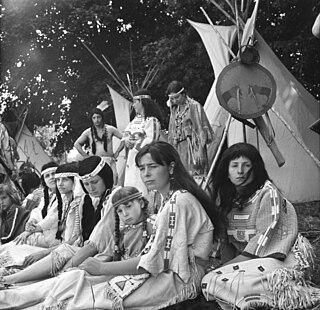
The Native American Graves Protection and Repatriation Act (NAGPRA), Pub. L. 101-601, 25 U.S.C. 3001 et seq., 104 Stat. 3048, is a United States federal law enacted on November 16, 1990.

Karl Friedrich May was a German author. He is best known for his 19th century novels of fictitious travels and adventures, set in the American Old West with Winnetou and Old Shatterhand as main protagonists and in the Orient and Middle East with fictional characters Kara Ben Nemsi and Hadschi Halef Omar.

Johann Carl Bodmer was a Swiss-French printmaker, etcher, lithographer, zinc engraver, draughtsman, painter, illustrator and hunter. Known as Karl Bodmer in literature and paintings, as a Swiss and French citizen, his name was recorded as Johann Karl Bodmer and Jean-Charles Bodmer, respectively. After 1843, likely as a result of the birth of his son Charles-Henry Barbizon, he began to sign his works K Bodmer.

George Catlin was an American adventurer, lawyer, painter, author, and traveler, who specialized in portraits of Native Americans in the American Frontier.

Alexander Crichlow Barker Jr., known as Lex Barker, was an American actor. He was known for playing Tarzan for RKO Pictures between 1949 and 1953, and portraying leading characters from Karl May's novels, notably as Old Shatterhand in a film series by the West German studio Constantin Film. At the height of his fame, he was one of the most popular actors in German-speaking cinema, and received Bambi Award and Bravo Otto nominations for the honor.

The Field Museum of Natural History (FMNH), also known as The Field Museum, is a natural history museum in Chicago, Illinois, and is one of the largest such museums in the world. The museum is popular for the size and quality of its educational and scientific programs, and its extensive scientific specimen and artifact collections. The permanent exhibitions, which attract up to 2 million visitors annually, include fossils, current cultures from around the world, and interactive programming demonstrating today's urgent conservation needs. The museum is named in honor of its first major benefactor, Marshall Field, the department-store magnate. The museum and its collections originated from the 1893 World's Columbian Exposition and the artifacts displayed at the fair.

Winnetou is a fictional Native American hero of several novels written in German by Karl May (1842–1912), one of the best-selling German writers of all time with about 200 million copies worldwide, including the Winnetou trilogy. The character made his debut in the novel Old Firehand (1875).

Scalping is the act of cutting or tearing a part of the human scalp, with hair attached, from the head, and generally occurred in warfare with the scalp being a trophy. Scalp-taking is considered part of the broader cultural practice of the taking and display of human body parts as trophies, and may have developed as an alternative to the taking of human heads, for scalps were easier to take, transport, and preserve for subsequent display. Scalping independently developed in various cultures in both the Old and New Worlds.

Old Shatterhand is a fictional character in Western novels by German writer Karl May (1842–1912). He is the German friend and blood brother of Winnetou, the fictional chief of the Mescalero tribe of the Apache. He is the main character in the Eurowestern by the same name from 1964, starring Lex Barker, as he does in six more films of the Winnetou film series.

The Glenbow Museum is an art and history regional museum in the city of Calgary, Alberta, Canada. The museum focuses on Western Canadian history and culture, including Indigenous perspectives. The Glenbow was established as a private non-profit foundation in 1955 by lawyer, businessman and philanthropist Eric Lafferty Harvie with materials from his personal collection.

The film Old Shatterhand is a successful Eurowestern based on the character Old Shatterhand, written by German novelist Karl May and part of the Winnetou series. It is a West German CCC Film production co-produced with French, Italian, and Yugoslav companies and filmed in 70mm. Financed with roughly DM 5,000,000, the film was the most expensive Karl May western. Composer Riz Ortolani used a chorus for his film score.

Repatriation is the return of the cultural property, often referring to ancient or looted art, to their country of origin or former owners.

The Peabody Museum of Archaeology and Ethnology is a museum affiliated with Harvard University in Cambridge, Massachusetts, United States. Founded in 1866, the Peabody Museum is one of the oldest and largest museums focusing on anthropological material, with particular focus on the ethnography and archaeology of the Americas. The museum is caretaker to over 1.2 million objects, some 900 feet (270 m) of documents, 2,000 maps and site plans, and approximately 500,000 photographs. The museum is located at Divinity Avenue on the Harvard University campus. The museum is one of the four Harvard Museums of Science and Culture open to the public.

John Mix Stanley was an artist-explorer, an American painter of landscapes, and Native American portraits and tribal life. Born in the Finger Lakes region of New York, he started painting signs and portraits as a young man. In 1842 he traveled to the American West to paint Native American life. In 1846 he exhibited a gallery of 85 of his paintings in Cincinnati and Louisville. During the Mexican–American War, he joined Colonel Stephen Watts Kearney's expedition to California and painted accounts of the campaign, as well as aspects of the Oregon Territory.

Wild West shows were traveling vaudeville performances in the United States and Europe that existed around 1870–1920. The shows began as theatrical stage productions and evolved into open-air shows that depicted romanticized stereotypes of cowboys, Plains Indians, army scouts, outlaws, and wild animals that existed in the American West. While some of the storylines and characters were based on historical events, others were fictional or sensationalized.
Shatterhand is a 1991 game for the Nintendo Entertainment System

The Desperado Trail is a 1965 West German film directed by Harald Reinl.
Heinz Werner Höber was a very prolific pulp fiction author who produced many novels about the fictitious FBI-agent Jerry Cotton and eventually sued his publisher because he felt he had been entitled to receive royalties.

Native Americans in German popular culture have, since the 18th century, been a topic of fascination, with imaginary Native Americans influencing German ideas and attitudes towards environmentalism, literature, art, historical reenactment, and German theatrical and film depictions of Indigenous Americans. Hartmut Lutz coined the term, Indianthusiasm, for this phenomenon.
During the American Indian Wars of the mid to late 19th century, Native American warriors of the Great Plains, sometimes referred to as braves in contemporary colonial sources, resisted westward expansion onto their ancestral land by settlers from the United States. Though a diverse range of peoples inhabited the Great Plains, there were a number of commonalities among their warfare practices.


















